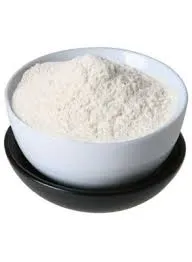
jul . 29, 2024 23:36 Back to list
Understanding Redispersible Polymer Powders and Their Applications in Construction and Coating Industries
Redispersible polymer powder (RDP) is a type of powder that can be re-dispersed in water to form a stable colloidal solution. These materials are extensively used in construction, paints, adhesives, and coatings due to their unique properties and advantages. RDPs are primarily derived from polymer emulsions through a spray-drying process, enabling them to retain their polymeric attributes while being transformed into a dry powder form that is easy to handle and transport.
One of the main benefits of using RDPs is their ability to improve adhesion and cohesion in various applications. When re-dispersed in water, the polymer particles can coalesce and form a film that enhances the bonding strength between materials. This is particularly important in applications like cement-based mortars and tile adhesives, where the integrity of the bond affects the overall performance and durability of the construction. The enhanced adhesion provided by RDPs ensures that structures are robust and can withstand the stresses imposed by environmental factors.
.
Moreover, RDPs serve to enhance water resistance and reduce permeability. This is essential in coatings and waterproofing applications, where moisture ingress can lead to significant damage and deterioration. By incorporating RDPs, manufacturers can create products that maintain their performance even under challenging weather conditions, ensuring long-term effectiveness.
redispersible polymer powder wikipedia

The versatility of RDPs is another key attribute that makes them widely used across various industries. They can be incorporated into numerous formulations, including self-leveling compounds, exterior insulation finishing systems (EIFS), and polymer-modified sealants. This adaptability allows manufacturers to tailor the performance characteristics of their products to meet specific requirements, which is invaluable in a market that demands customization and innovation.
Environmentally, RDPs are often viewed as a sustainable option, especially when compared to traditional solvent-based systems. Many RDPs are produced from renewable raw materials, and their use can contribute to lower volatile organic compound (VOC) emissions. The shift towards eco-friendly products in the construction and manufacturing industries aligns well with the growing emphasis on sustainability, making RDPs an attractive option for environmentally-conscious consumers and businesses.
However, despite their many advantages, there are challenges associated with the use of redispersible polymer powders. One of the primary concerns is the need for proper storage and handling to prevent moisture absorption, which can affect the performance of the powder. Additionally, the re-dispersion process must be carefully controlled to ensure uniformity and consistency, as improper mixing can lead to clumping and reduced effectiveness.
In conclusion, redispersible polymer powders are vital components in modern construction and manufacturing, providing enhanced adhesion, flexibility, water resistance, and overall product performance. Their ability to transform into a usable form upon mixing with water makes them an efficient choice for numerous applications. As industries continue to seek sustainable and high-performance materials, the role of RDPs is likely to grow, driving innovation and improvements in product development. The future of redispersible polymer powders looks promising, with ongoing research and advancements paving the way for even broader applications and enhanced formulations.
-
The Widespread Application of Redispersible Powder in Construction and Building Materials
NewsMay.16,2025
-
The Widespread Application of Hpmc in the Detergent Industry
NewsMay.16,2025
-
The Main Applications of Hydroxyethyl Cellulose in Paints and Coatings
NewsMay.16,2025
-
Mortar Bonding Agent: the Key to Enhancing the Adhesion Between New and Old Mortar Layers and Between Mortar and Different Substrates
NewsMay.16,2025
-
HPMC: Application as a thickener and excipient
NewsMay.16,2025
-
Hec Cellulose Cellulose: Multi functional dispersants and high-efficiency thickeners
NewsMay.16,2025







